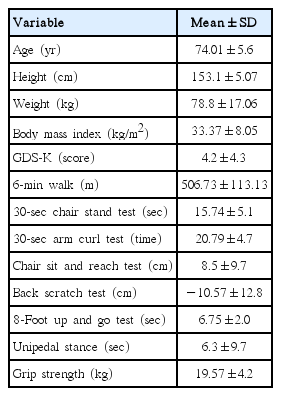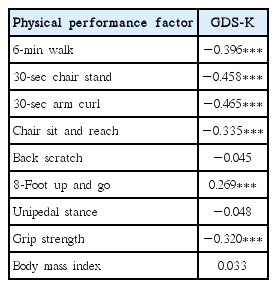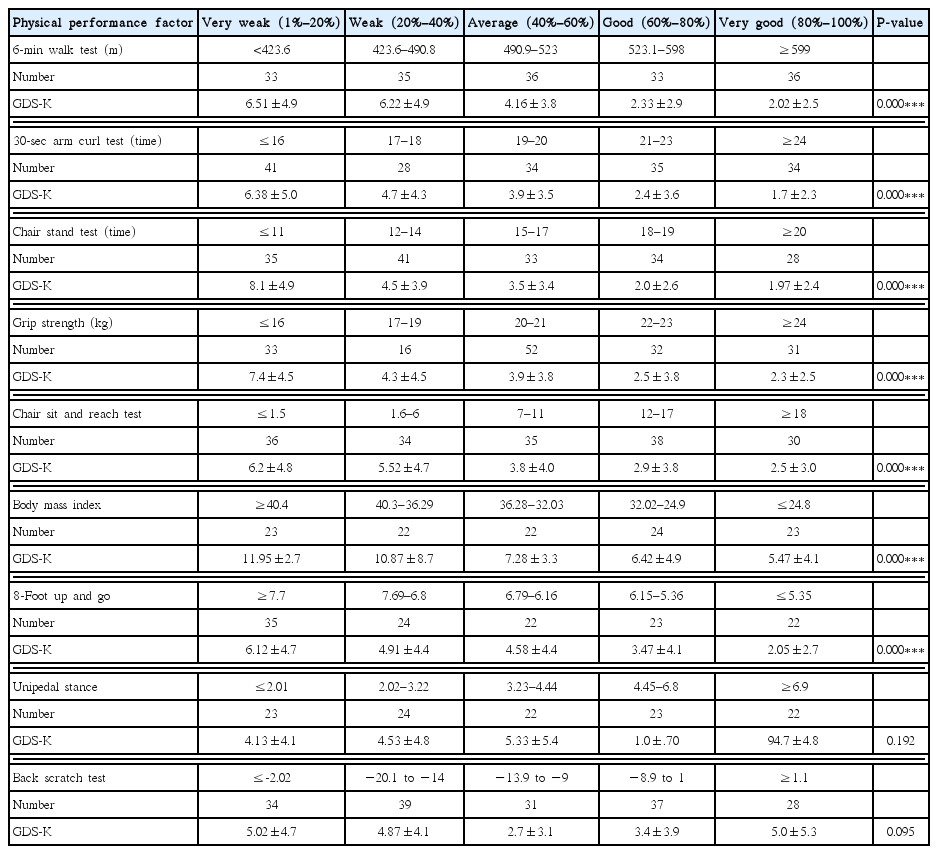A study of the relationship between depression symptom and physical performance in elderly women
Article information
Abstract
Depression is a general public health problem; there is an association between regular exercise or vigorous physical activity and depression. Physical activity has positive physical, mental, and emotional effects. The purpose of this study was to examine the relationship between depression symptom and physical performance in elderly women. A total of 173 elderly women aged 65 to 80 participated in this study. We evaluated elderly women using the 6-min walk, grip-strength, 30-sec arm curl, 30-sec chair stand, 8-foot up and go, back scratch, and chair sit and reach, and unipedal stance, measured the body mass index (BMI), and depression symptom assessed using Korean version of the Geriatric Depression Scale (GDS-K). The collected data were analyzed using descriptive statistics, correlation analysis, paired t-tests, and simple linear regression using IBM SPSS Statistics ver. 21.0. There were significant correlations between GDS-K and the 6-min walk, 30-sec chair stand, 30-sec arm curl, chair sit and reach, 8-foot up and go, and grip strength tests (P<0.05), but not BMI, back strength, and unipedal stance. When divided into two groups (GDS-K score≥14 and GDS-K score<14), there was a difference between the two groups in the 6-min walk, 30-sec chair stand, 30-sec arm curl test, chair sit and reach, 8-foot up and go test, and grip strength test performances. Physical performance factors were strongly associated with depression symptom, suggesting that physical performance improvements may play an important role in preventing depression.
INTRODUCTION
In the elderly, overall physical functioning declines, and incidence rates of anxiety and depression, and impairments of memory, cognition, and intelligence increase. As these factors lower the quality of life, increasing numbers of the elderly are committing suicide (Gebretsadik et al., 2006). According to data of the National Health Insurance Service of Korea (2013), the prevalence of depression in Koreans over 65 yr of age continues to increase, and the results of an epidemiological study showed that the prevalence of depression is associated with an increased elderly suicide rate (Lee et al., 2014). Elderly depression is strongly associated with cognitive function. The elderly with dementia have severe problems in all aspects of health including depression, apprehension, anxiety, unhappiness, lowered cognitive function, and decreased social activities (Goodwin, 2003; Ryu et al., 2000). Although the incidence of cognitive impairment among the elderly without dementia is only 13%, the incidence of cognitive impairment accompanied by depression is reportedly more than 52%. In addition, the rate of cognitive decline is over 20% more rapid in the elderly with depression than in those without depression, which indicates depression is an independent predictor of cognitive decline in the elderly (Wilson et al., 2004).
Depression is a general public health problem, and is reported to be associated with many physical diseases, such as cardiovascular disease and diabetes (Carney et al., 2002; Newcomer et al., 2002). Symptoms of depression include depressed mood, decline in enthusiasm, and sleep disorders, and depression induces a decline in mental and cognitive function, causing difficulties in daily living (van Milligen et al., 2011). Regular exercise and vigorous physical activity exert a positive influence on the physical and mental health of the elderly (Park and Kim, 2011). They contribute to improvements in physical performance, including strength, flexibility, agility, balance, and cardiopulmonary endurance, and are effective in creating psychological stability and happiness. Moreover, they are also reported to decrease mild or severe depression (Morgan and O’Connor, 1988). Yamagata et al. (2013) investigated the association between depression and level of physical performance in 886 elderly Asians and reported that limb strength and cardiopulmonary endurance were lower in the group with symptoms of depression than in the group without any symptoms. Enright et al. (2003) investigated the association between the depression index and cardiopulmonary endurance in 2,117 American elderly and reported a significant negative correlation between the two factors. Moreover, Ho et al. (2008) investigated the association between waist-hip ratio and the depression index in 2,604 Asian adults, and reported a significant positive correlation between the two factors (Vogelzangs et al., 2008). Vogelzangs et al. (2008) compared body fat percentage in groups with and without symptoms of depression and reported that body fat percentage was significantly higher in the group with depression symptoms (Hamilton, 2010). As noted above, the depression index is thought to be associated with the level of physical performance and indices of obesity. However, reports of this association in elderly Koreans are lacking, and studies that suggest a standard of physical performance for prevention of depression are required (Suija et al., 2013). Therefore, we aim to clarify the association between depression and physical performance in elderly females and to suggest a standard of physical performance for prevention of depression.
MATERIALS AND METHODS
Participants
A total of 173 women, 65–80 yr old, living in Inchon city, participated. All potential participants underwent a comprehensive explanation of the proposed study, its benefits and inherent risks, and the expected time commitment. Medical information (health status and medications) was obtained from participants using a questionnaire. The subjects were excluded if they were not able to walk without a cane or other assistive device, or had known conditions and musculoskeletal problems limiting safe participation in this study. The demographic data are shown in Table 1.
Instruments
Physical performance test
The physical performance test for seniors was developed by Rikli and Jones (2012) included 6-min walk, grip strength, 30-sec arm curl, 30-sec chair stand, back scratch, chair sit and reach, 8-foot up and go, unipedal stance, and body mass index.
Korean version of the Geriatric Depression Scale assessment
Geriatric Depression Scale (GDS) assessment is a basic measurement tool originally developed by Yesavage et al. (1982). The Korean version of the GDS (GDS-K) evaluation tool used in the present study consists of a Korean adaptation that was restructured by Jung et al. (1997). This questionnaire consists of two scales, and is comprised of 30 questions. When analyzing the results of depression scale assessment, the optimal cutoff point of the GDS-K score, which is 14, was used as a standard; participants with scores of 14 or higher were classified as the group with symptoms of depression, and participants with scores lower than 14 were classified as the control group without symptoms of depression. Cronbach α at the time of development of the GDS-K was 89.
Statistical analysis
Statistical analysis was performed using IBM SPSS Statistics ver. 21.0 (IBM Co., Armonk, NY, USA). An analysis was conducted to examine the correlation between depression and physical performance factors, and GDS-K scores were divided into two groups (GDS-K score≥14 and GDS-K score<14) to analyze the differences between groups using the paired t-test; physical performance factors were divided into quintiles to analyze the differences between groups. Data were analyzed using linear regression and descriptive statistics. The significance threshold was set at 0.05.
RESULTS
There was a significant correlation between GDS-K score and the 6-min walk, 30-sec chair stand, 30-sec arm curl test, chair sit and reach, 8-foot up and go test, and grip strength (P<0.05), but not BMI, back strength, and unipedal stance (Table 2). When divided into two groups (GDS-K score≥14 and GDS-K score<14), there was a difference between the two groups in the 6-min walk, 30-sec chair stand, 30-sec arm curl test, chair sit and reach, 8-foot up and go test, and grip strength (Table 3).
Analysis of GDS-K scores after the division of each physical performance factor into quintiles showed that GDS-K was lower as physical performance increased (Table 4). Moreover, the group with the highest level of physical performance (>80%) had the lowest risk of depression symptoms compared to the group with the lowest level of physical performance (<20%). The group with high physical performance (>80%) according to the 6-min walk, 30-sec chair stand, 30-sec arm curl, 8-foot up and go, and grip strength tests, and BMI had lower GDS-K scores than the cutoff point suggested by Jung et al. (1997).
DISCUSSION
Our study shows that a high level of physical performance is associated with low levels of depression symptoms in elderly women. There was an especially significant correlation between GDS-K and the 6-min walk, 30-sec chair stand, 30-sec arm curl test, chair sit and reach, 8-foot up and go test, and grip strength. These results are consistent with previous research showing an association with depression symptoms. In a study by Gerber et al. (2013), elderly subjects were subdivided into a group with depression symptoms and a normal group, according to cardiorespiratory endurance level. The level of depression was investigated in each group with exposure to stress; the group with higher cardiorespiratory endurance level had a lower level of depression, and the result coincided with this report. Moreover, our results agreed with another study that analyzed the association between strength and depression level after application of physical activity, and reported that the depression level decreased with increased strength (Singh et al., 2005). These results show that cardiorespiratory endurance and strength level, which are components of physical performance, are directly related to depression, and that improvement in physical performance through regular exercise or vigorous physical activity can exert a positive influence and improve depression by aiding the recovery of self-confidence or inducing emotional responses in the elderly. Although our analysis showed no association between the depression level and BMI, previous studies had reported that depression was associated with BMI, waist circumference, and waist-hip ratio (Rantanen et al., 2000; Wiltink et al., 2013). In contrast, a study that investigated the association between depression symptoms and BMI among elderly Koreans reported that a significant association was not observed (Lee et al., 2014). Based on these results, the indices of obesity and depression level seem to be associated with each other, although not obviously. As there seem to be differences by country, additional studies are required in the future. In this study, depression symptoms were shown to be associated with a test of agility, the 8-foot up and go, for which Lee et al. (2014) reported a strong correlation. In conclusion, strength, strength endurance, cardiorespiratory endurance level, and improvement in agility are thought to exert positive influences on depression. Moreover, there is a need for additional studies that can prove a causal relationship, through application of exercise programs to improve strength, strength endurance, cardiorespiratory endurance level, and agility, with the ultimate goal of preventing and improving depression.
ACKNOWLEDGMENTS
This study was support by Gachon University Grand (GCU-2014-0174).
Notes
CONFLICT OF INTEREST
No potential conflict of interest relevant to this article was reported.



